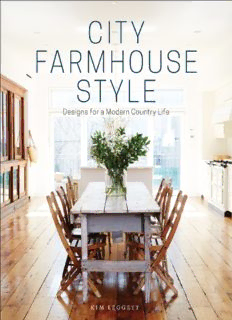
City Farmhouse Style: Designs for a Modern Country Life PDF
Preview City Farmhouse Style: Designs for a Modern Country Life
CONTENTS FOREWORD BY RACHEL HARDAGE BARRETT INTRODUCTION CHAPTER 1 FARMHOUSE INSPIRATION THE WAY WE WERE FARMHOUSE PAINTS FARMHOUSE WALLPAPERS FARMHOUSE TEXTILES CHAPTER 2 THE UPTOWN CITY FARMHOUSE THE MODERN FARMHOUSE TUCKED-AWAY CHARM PURE COUNTRY MADE FROM SCRATCH ROOTED IN THE PAST THE FRENCH FARMHOUSE CHAPTER 3 THE SUBURBAN CITY FARMHOUSE FRESH START SWEET HARMONY THE DESIGNER’S FARMHOUSE SALVAGED STYLE CHAPTER 4 THE CREATIVE CITY FARMHOUSE THE WRITER’S LOFT SOPHISTICATED STUDY TOP-OF-THE-TOWN GARDEN CHAPTER 5 PICKIN’ PLACES RESOURCES FOR CREATING CITY FARMHOUSE STYLE ABOUT THE AUTHOR There’s a simplicity to farmhouse staples that helps them play well with other design elements and aesthetics, whether your tastes veer toward the modern, traditional, or somewhere in between. FOREWORD Chalk it up to the ubiquitous farm-to-table trend, but it seems that anything branded with the word “farmhouse” is suddenly having a moment—from simple white farmhouse kitchens to amber-hued farmhouse ales. Farmers, of course, were doing “farm-to-table” far before it became the hyphenate du jour on highfalutin city menus, and those same farming folk knew the merits of, say, a wide-bowl apron sink or easy-access open shelving well before those items became staples of designer portfolios and home décor catalogs. The real beauty of farmhouse style—unlike other more fleeting design trends —is that it’s rooted in roll-up-your-sleeves practicality. Farmhouses have been around for hundreds of years, after all, and they were designed to work hard—to accommodate multigenerational families, feed a crowd, and, yes, handle a little dirt. As the editor in chief of Country Living, a brand with design-loving readers all over the country, I’ve seen firsthand how the demand for all things farmhouse has grown exponentially over the past few years—and well beyond the county lines of honest-to-goodness farm towns. Farmhouse style seems to resonate everywhere, from the neon lights of Times Square to one-stoplight town squares, and for good reason: A farmhouse table or an apron sink work just as well in an urban loft or suburban Tudor as they do in a country farmhouse. I also suspect farmhouse style has such widespread appeal because it’s inherently inviting. It’s warm, welcoming, and, thanks to its adaptability, all- inclusive. At Country Living, we run across hundreds of objectively beautiful spaces every month, but our most important criteria when vetting homes is this: Does it make you want to fidget, or does it make you want to linger? If it’s the former, it falls into the “no” pile. A farmhouse-inspired home, if done right, certainly doesn’t make you want to fidget. Nothing about farmhouse style is too precious, too sleek, too hard-lined, or too cold. It’s no surprise, then, that Kim Leggett, the brilliant design mind behind the lifestyle brand, blog, and boutique City Farmhouse (and author of this very book), has helped plant and grow the seeds of the farmhouse-style movement. Yes, she has an incredible eye for good design, but perhaps more important, she embodies the warm, open, friendly aesthetic of the farmhouse look. Our paths first crossed at a Country Living fair event several years ago, where, after I likely spent too much money in her perfectly curated booth, we started talking and realized that we both hail from the same small farming town nestled in the northwest corner of Tennessee. Maybe it’s because the muddy water of the Mississippi is thicker than blood, but Kim immediately felt like family. But here’s the thing: I suspect she has that “you’re one of my people” effect on pretty much everyone, and therein lies her personal sit-and-stay-awhile charm. That sense of personal connection is another check mark in favor of farmhouse style, isn’t it? At the risk of sounding a little “crotchety old man,” I’ve found that modern-day social media connections simply can’t compete with a sprawling front porch that fosters impromptu (in-person!) conversations with your neighbors or a long farmhouse table designed for sit-down Sunday suppers. Even other hallmarks of farmhouse style—family heirlooms, cleverly upcycled accents—are intended to connect us with the past. Creaky hardwood floors remind us of those who walked before us, as do the resourcefully repurposed items that decorate our planked walls and open shelves. (Now, if only someone could come up with a clever way to repurpose a Mason jar …) An aesthetic movement that not only values but also celebrates all things old, chipped, and weathered is pretty much destined to have longevity. Twenty years from now, you may question that chevron wallpaper or those ikat draperies, but you won’t regret a cast-iron claw-foot tub or an heirloom-worthy iron bedframe. Farmhouse style is time-tested. It has staying power. You can bet the farm on it. —RACHEL HARDAGE BARRETT, editor in chief, Country Living Farmhouse style is the design equivalent of “sit and stay awhile.”
Description: